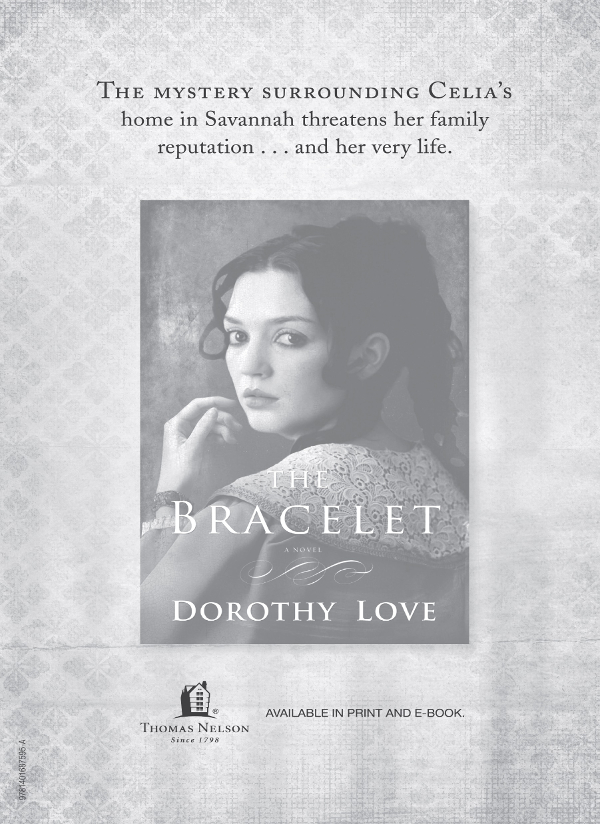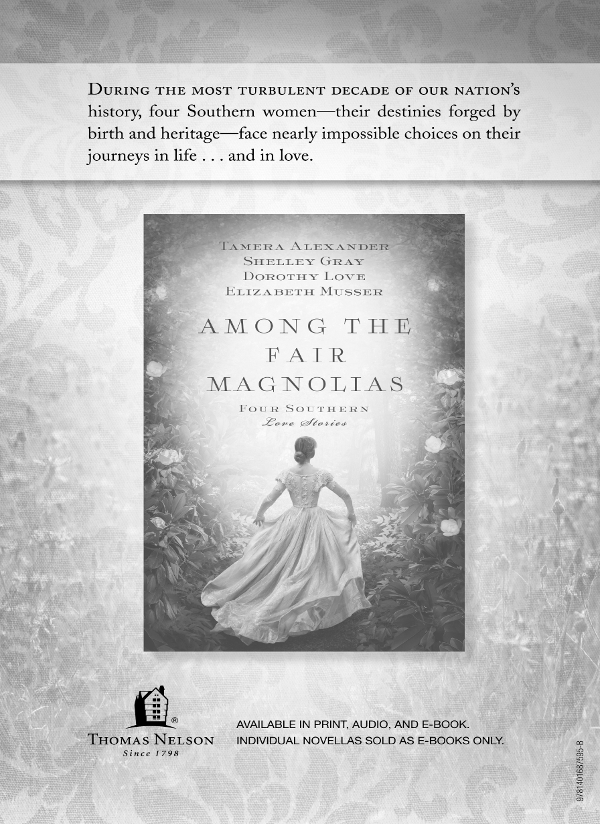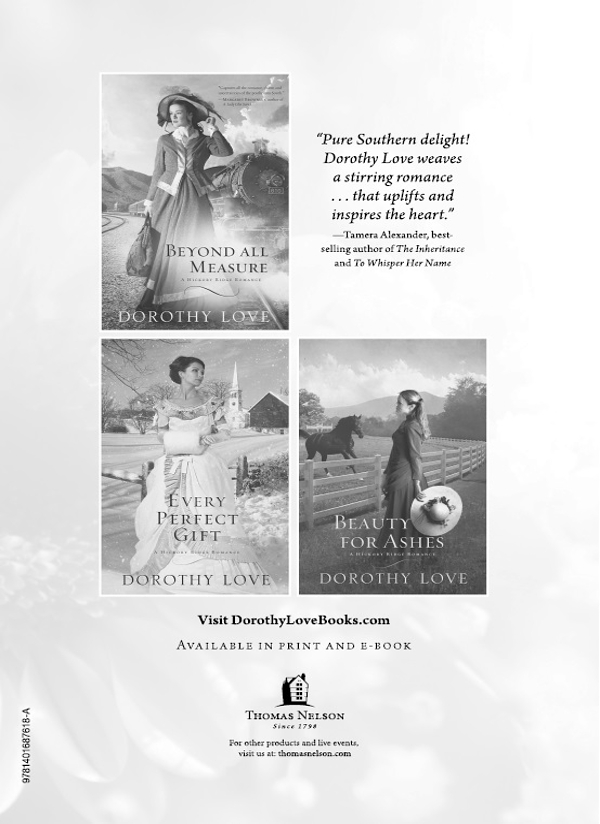A Respectable Actress (41 page)

The last lines were spoken, and the players exited the stage. A moment of silence
ensued as the audience emerged from the world of fantasy and returned to the present.
The applause and cheers were enthusiastic and prolonged, swelling anew as each of
the players returned to the stage for a final bow.
When Victoria Bryson's turn came, she dropped a quick curtsy, then ran to the wings
and grabbed India's hand.
“Come on!” Her eyes luminous with triumph, the girl tugged India onto the stage,
then led another round of applause. Moving as one, the players took a step back,
leaving India alone in the dazzling limelight.
She looked out at the packed house. Philip sat in the front row to the left of center,
flanked by Mr. Shakleford and Mr. Kennedy. Philip blew her a kiss, and she briefly bowed her head, both hands clasped to her chest.
Across the aisle sat Celia Mackay with Frannie and an attractive man India realized
must be Celia's husband, Sutton, returned from his travels at last. From their places
in the wings,
Riley Quinn, Miss Sawyer, and Fabienne were clapping wildly, tears
running down their faces.
India's eyes welled up as the applause washed over her, a wave of affection that
filled her heart to bursting. Life was lived on an ever-turning wheel that sooner
or later brought a person back to her truest self. She thought of everything she
had lost and gained. Everything she had been through that had led her here.
Someone tossed a bouquet of jonquils onto the stage. She retrieved it and pressed
the blossoms to her nose. She thought of her father, that dear, flawed man whose
faith in her had never wavered. She could almost feel his presence on the stage beside
her, his favorite line from
King Lear
a whisper in her ear.
The wheel is come full circle. I am here.
THE END
Dear Readers,
This novel, like all of my others, is inspired by the life of a real nineteenth-century woman.
A Respectable Actress
owes its beginnings to Frances “Fanny” Anne Kemble, one of the most famous and beloved actresses of her day and the inspiration for my fictional actress India Hartley.
Born into an English family of actors that included her aunt Sarah Siddons, Fanny
made her London stage debut as Juliet at age nineteen and was an immediate sensation.
She often acted with her father, Charles, a Shakespearean actor who managed the Covent
Garden theater. As her fame grew and his popularity waned, she found herself the
family's major breadwinner.
In 1832, after three dazzling seasons in London, Fanny traveled to America with
her father, in part to help pay for her father's increasing debts. Accustomed to
acclaim everywhere they went, the Kembles were surprised to find the American aristocracy
suspicious of theater people. The majority of native-born actors and actresses were
from the lower social classes. But Fanny's opening-night performance and many that
followed enchanted the critics and soon made her a celebrity. University students
cut
classes to attend her matinee performances. Women copied her hairstyle, and garden
clubs named flowers in her honor.
During a tour in Philadelphia, Fanny met Pierce Butler, scion of a wealthy Georgia
plantation owner. Though he was engaged to another woman, Butler began courting Fanny.
They married in June of 1834, and two years later Pierce Butler inherited the second
largest slaveholding empire in Georgia.
Fanny was horrified. She began keeping a journal during her time at Butler's Island,
which is part of St. Simons Island, where my fictional hero Philip Sinclair has his
plantation, Indigo Point. Fanny's journal details her discomfort and unhappiness
among the slaves, snakes, and plantation families of the island, but more importantly
her journal is a commentary on slavery, race, and the rights of women. It was published
in 1863 as
Journal of a Residence on a Georgian Plantation,
and it became a popular
argument against slavery. Some historians have speculated that some of the details
she supplied in her journal may have been exaggerated, though there is no doubt the
slaves were subjected to inhumane treatment before Butler sold them in one of the
largest auctions of human beings ever recorded. I used Fanny's journal in creating
my character Laura Sinclair, whose distaste for plantation life at Indigo Point leads
to dire consequences.
Fanny and Pierce Butler had two daughters, born on the same day three years apart.
When the Butlers divorced in 1849, Sarah Butler sided with her mother and eventually
married Owen Jones Wister, a wealthy physician. Their son, also named Owen Wister,
was the celebrated author of
The Virginian
, widely acknowledged as the first cowboy
novel. The Butlers' other daughter, named Frances but called “Fan,” supported her
father and after the war attempted to salvage his plantations on Butler's Island.
It is this daughter who has an offstage role in
A Respectable Actress
as friend to
my fictional Amelia Sinclair.
Indigo Point is entirely fictional, but it's modeled after King's Retreat, a large
plantation on the southern tip of St. Simons Island. In the 1870s and 1880s, Anson
Dodge and his business partner at King's Retreat operated a lumber mill that grew
to be the third largest in the country. In creating Indigo Point, I relied upon the
collected letters of Anna Matilda Page King, who inherited King's Retreat from her
father and reared her ten children there, managing it during her husband's long absences.
Modern readers may wonder how India's murder trial could have lasted for only a few
days. And they may wonder about India's escape to the Isle of Hope. Both of these
events are taken from the pages of history. In creating India's trial, I read the
handwritten records of murder trials of the mid-to late nineteenth century, many
of which lasted only two to three days. One record describes the trial of a Missouri
slave woman accused in the death of her master. Known only as “Molly,” she was convicted
in two days' time on the testimony of a handful of witnesses and swiftly sentenced
to death by hanging. While she was in jail awaiting the results of her appeal, someone
who was never identified spirited Molly out of the jail and hid her in a place of
safety until her appeal was processed. Of course it was denied, and Molly was subsequently
hanged.
The interested-party rule that Philip Sinclair mentions was indeed a rule that prevented
the accused from testifying on their own behalf.
Readers of
The Bracelet
will recognize the main character
from that story, Celia
Browning Mackay. I loved Celia so much I couldn't leave her behind, and since St.
Simons Island is so close to Savannah, it was easy to bring her back into this story
as India's champion and benefactor. I hope fans of Celia's story will enjoy catching
up with her ten years after she set sail for Liverpool with her new husband.
The Southern Palace Theater and all other characters in the novel are fictional.
A Respectable Actress
is a story of love and betrayal, of courage and hope, and a
window into the world of the nineteenth-century theater and the history and beauty
of St. Simons, one of the loveliest places I know. It is surely deserving of its
nickname as a “golden isle.”
San Antonio, March 2015
1. How does the notion of “respectability” affect the way in which India sees herself?
How does it color her perception of her relationship with Philip?
2. India's nomadic lifestyle causes her to long for a real homeâa refuge no theater
can provide. What is your definition of home?
3. India suffers the effects of being thought of as an outsider. Have you ever felt
that way about yourself? How did it influence your choices?
4. What do you think acting means to India? How do her skills influence the outcome
of the story?
5. Were you surprised by the outcome of India's trial? Why or why not?
6. What did you think of Philip's decision not to tell India about his past until
he was forced to do so? How would his revelations have altered the story and their
relationship?
7. If you have read
The Bracelet
, what did you enjoy most about this glimpse into
Celia Mackay's life ten years later? Were you surprised that she took up India's
cause?
8. What role do the two islandsâSt Simons and Isle of Hopeâplay in the story? What
do they mean to Philip? To India? To Amelia?
9. Toward the end of the story, Philip tells India to let go of her worries about
Mr. Philbrick and his crimes. What do you think will happen to Mr. Philbrick?
10. Imagine India's and Philip's lives ten years later. What are they doing? Where
do they live? How have their triumphs and tragedies shaped their lives?
B
EGINNING WITH THE WONDERFUL PUBLISHING TEAM
at Thomas Nelson who takes such great care of me and my work, Becky Philpott and Erin Healy. Your careful reading and insightful comments make my work better. Kristin Ingebretson, thank you for another stunning book cover. I appreciate your talent more than words can say. To my copy editors and marketing and sales teams and all who work behind the scenes to bring a book to completion, thank you so much.
Natasha Kern, thank you for your wisdom and kindness. Working with you is a joy.
I'm indebted to the authors of several books I consulted regularly as I worked on
this novel including
Fanny Kemble's Civil Wars
by Catherine Clinton;
Anna, The Letters
of a St. Simons Island Plantation Mistress
by Anna Matilda Page King (edited by Melanie
Pavich-Lindsay);
Journal of a Residence on a Georgian Plantation in 1838â1839
by
Frances Anne (Fanny) Kemble, and
Within the Plantation Household: Black and White
Women of the Old South
by Elizabeth Fox-Genovese.
To family and friends near and far, your love and encouragement are a daily blessing
to me, and I thank you all.



